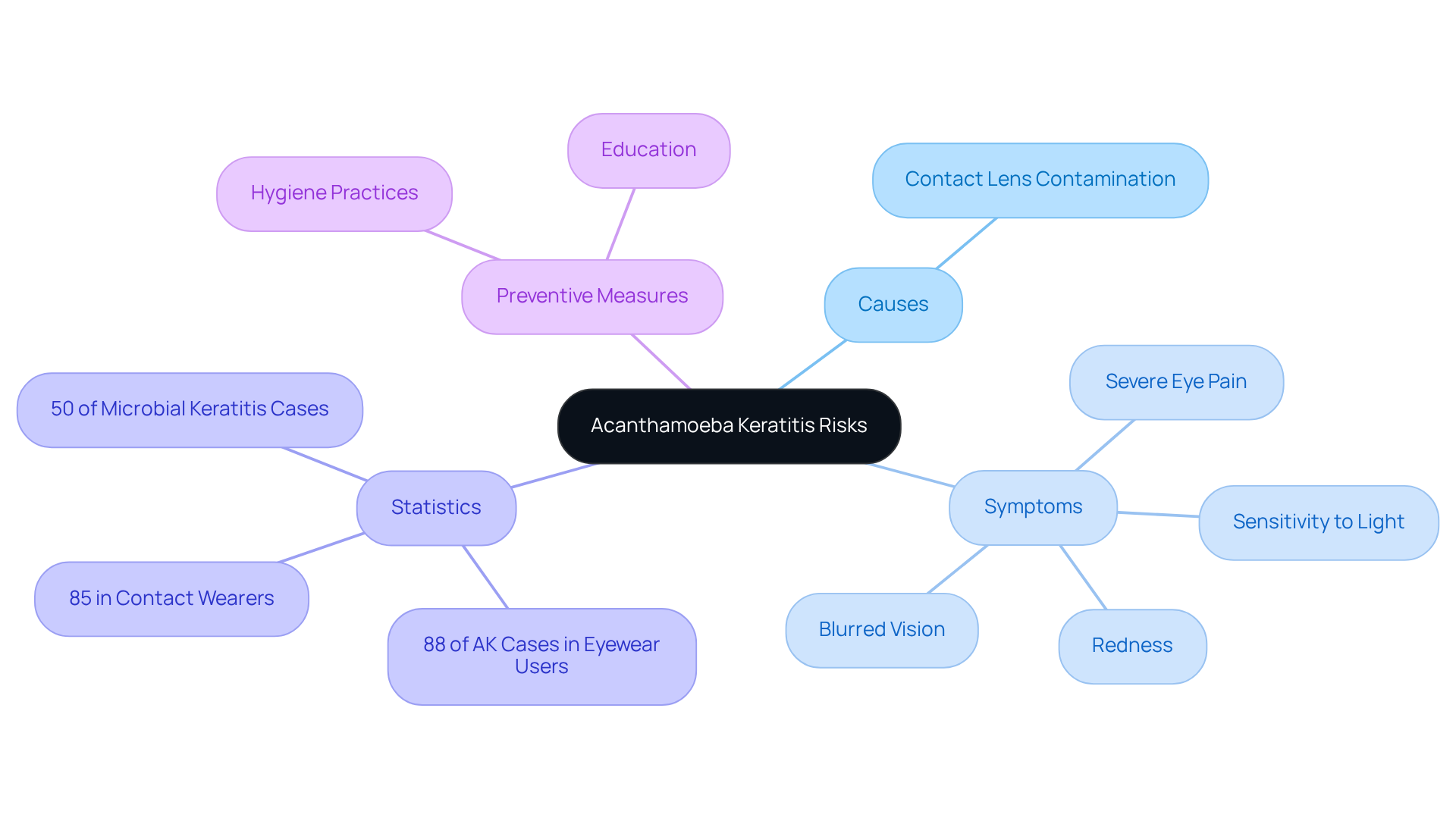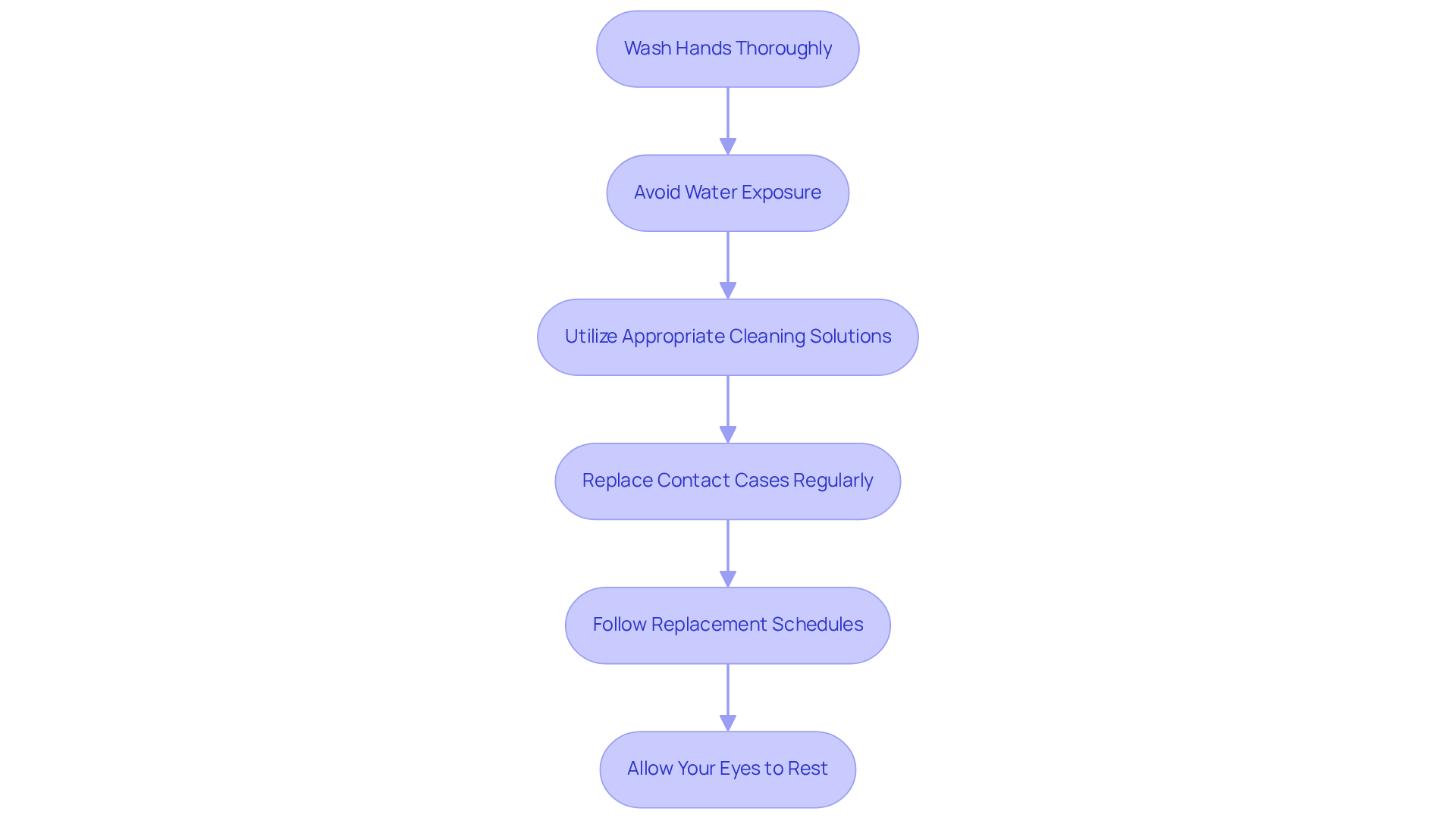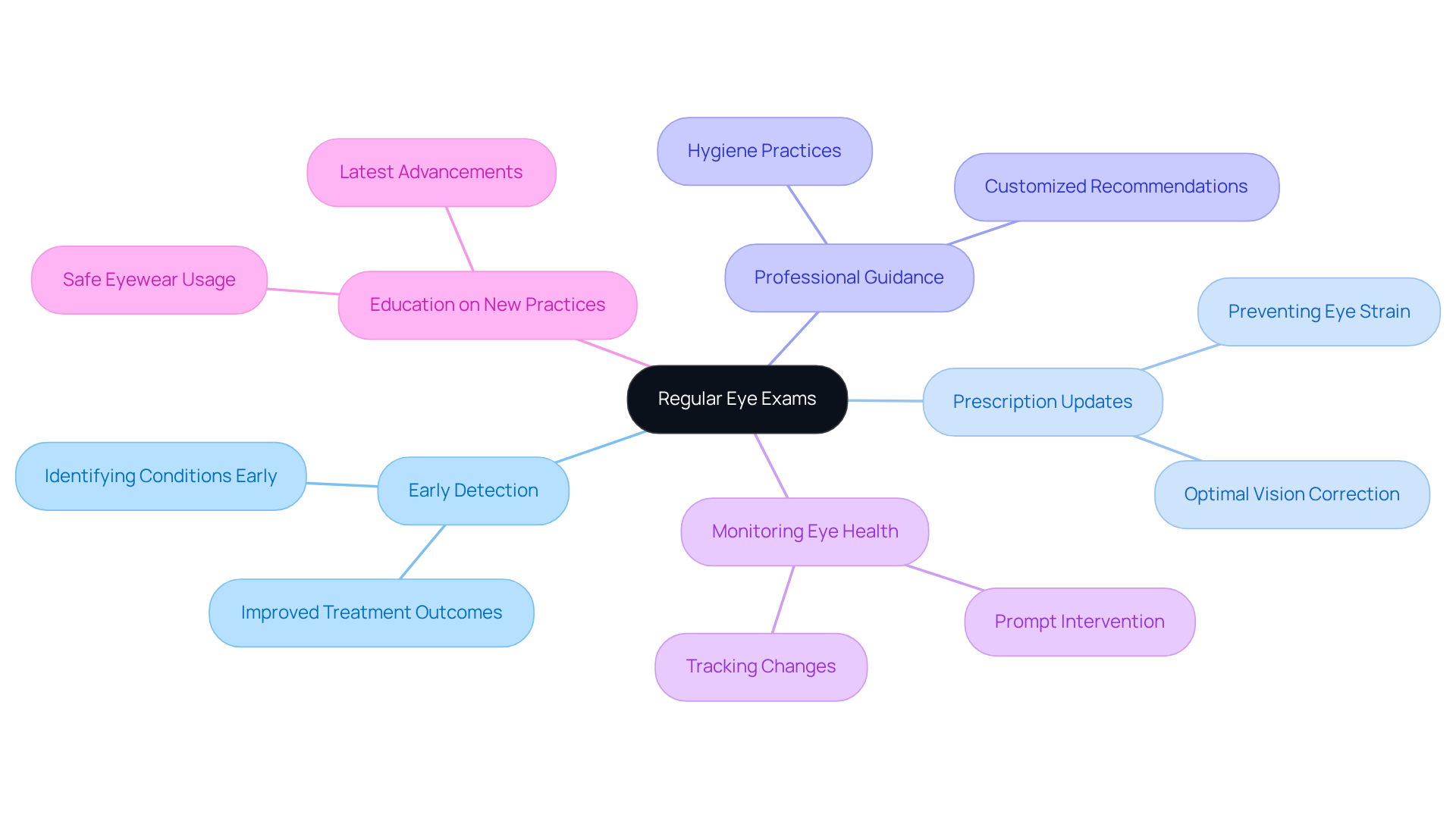Posted by: Northwest Eye in General on July 30, 2025
Overview
To prevent Acanthamoeba keratitis, we understand that contact lens users have concerns about their eye health. It’s essential to adhere to important hygiene practices, such as:
- Washing your hands before handling lenses
- Avoiding exposure to water
- Using appropriate cleaning solutions
These preventive measures are crucial in reducing the risk of infection and ensuring optimal eye health. Regular eye exams are also vital, as Acanthamoeba keratitis is particularly prevalent among contact lens wearers. We are here to help you through this process and support your eye health journey.
Introduction
Acanthamoeba keratitis, a rare yet severe eye infection, poses a significant threat to contact lens users. We understand that this condition can lead to distressing symptoms and potential vision loss, which can be deeply concerning.
Alarmingly, statistics reveal that a staggering 85% of cases occur among those who wear contacts. This highlights the importance of understanding the risks involved and implementing preventive measures to safeguard your eye health.
How can you, as a contact lens wearer, effectively navigate this hidden danger and ensure your vision remains intact? We are here to help you through this process.
Understand Acanthamoeba Keratitis and Its Risks for Contact Lens Users
Acanthamoeba keratitis (AK) is a serious but rare eye infection caused by the Acanthamoeba parasite, commonly found in water and soil. We understand that are especially vulnerable due to the risk of contamination during handling. Symptoms of AK can be distressing, including severe eye pain, redness, blurred vision, and sensitivity to light. If left untreated, this condition can lead to permanent vision loss, with approximately 25% of keratitis cases necessitating corneal transplants. Recognizing these risks is the first step in prevention, highlighting the importance of proper hygiene and care practices.
Real-world data underscores the severity of this condition; roughly 50% of microbial keratitis cases resulting in vision loss are linked to Acanthamoeba infections, particularly among users of vision correction devices. A study revealed that 88% of reported AK cases involved individuals who used eye wear, stressing the critical need for awareness and preventive measures. Alarmingly, 85% of instances of acanthamoeba keratitis occur within contact wearer populations, further illustrating the dangers associated with their use.
Recent studies indicate that the likelihood of developing AK is significantly higher in users of daily wear reusable contacts compared to those utilizing daily disposables. In fact, the occurrence of AK in daily wear contact users is more than three times higher, emphasizing the necessity of adhering to safe practices. Misdiagnosis is also a concern, as many patients are often mistakenly treated for viral or bacterial keratitis, which can delay effective treatment. The PCR test for detecting Acanthamoeba is more sensitive than previous culture methods, which can greatly improve diagnosis and treatment outcomes.
Preventive strategies are essential. We encourage proper hygiene methods, such as avoiding exposure of contact lenses to water and ensuring regular disinfection, as these practices can drastically reduce the risk of infection. Educational programs aimed at informing eyewear users about these risks are vital for public health. As Dr. Josep Torras wisely noted, ‘It is very important to diagnose Acanthamoeba keratitis early so that treatment is more effective,’ reinforcing that awareness and education are key components in combating this disease.

Implement Safe Contact Lens Practices to Prevent Infection
To effectively prevent acanthamoeba keratitis, we recognize that contact lens users might have concerns regarding their eye health. Here are some essential practices to help you feel more secure:
- Wash Hands Thoroughly: Always with soap and water before handling your eyewear. Dry them with a lint-free towel to avoid transferring bacteria. We know that maintaining cleanliness is vital for your safety.
- Avoid Water Exposure: It’s common to feel tempted to rinse contact lenses with tap water or wear them while swimming, showering, or using hot tubs. However, water can introduce harmful microorganisms. Studies indicate that exposure to water significantly raises the likelihood of infection, so it’s best to keep your lenses dry.
- Utilize Appropriate Cleaning Solutions: Clean and disinfect your optical devices with solutions recommended by your eye care provider. Reusing old solution or merely topping off with new solution diminishes the effectiveness of disinfection, increasing the risk of complications. Remember, it’s essential to change the solution in your container every day to ensure cleanliness.
- Replace Contact Cases Regularly: We recommend changing your contact case every three months to prevent contamination. Regular replacement is crucial, as infrequent changes can lead to serious eye infections.
- Follow Replacement Schedules: Adhering to the suggested replacement timeline for your contacts—whether they are daily, bi-weekly, or monthly disposables—is important. Noncompliance with these schedules is commonly reported among wearers and can lead to discomfort and infections. We understand that keeping track can be challenging, but it’s worth it for your eye health.
- Allow Your Eyes to Rest: We encourage you to take out your contacts prior to sleeping to enable your eyes to breathe and lessen the chance of infection. Sleeping in eye lenses can elevate the chance of infection by as much as eight times.
By implementing these practices, you can significantly reduce your risk of acanthamoeba keratitis, a condition that affects over 23,000 individuals worldwide each year, while maintaining optimal eye health. Remember, the best method to avoid eye infections caused by acanthamoeba keratitis is to consistently adhere to appropriate eyewear care guidelines as recommended by your eye doctor. We are here to help you through this process.

Schedule Regular Eye Exams and Consultations for Optimal Eye Health
Arranging routine eye examinations is essential for preserving optimal eye health, especially for users of corrective eyewear. We understand that taking care of your eyes can feel overwhelming at times, but here are the key reasons why prioritizing these exams is so important:
- Early detection through regular eye exams is vital for identifying the early signs of acanthamoeba keratitis and other eye conditions before they escalate into serious issues. It’s common to feel anxious about potential problems, but studies indicate that early detection significantly improves treatment outcomes. In fact, timely intervention can reduce the risk of severe complications by up to 50%.
- Prescription Updates: Vision alterations can happen gradually, and we know that it can be frustrating to deal with changes. That’s why it’s essential to have your contact prescription updated regularly. This ensures and comfort, preventing issues like blurred vision and eye strain associated with outdated prescriptions.
- Professional Guidance: Eye care specialists offer customized recommendations on eyewear maintenance and hygiene practices suited to your lifestyle. We recognize that navigating eye care can be challenging, and this guidance is particularly important for preventing infections and maintaining overall eye health. Dr. Griffey emphasizes that ‘proper care of eyewear is crucial to prevent issues that can occur from incorrect usage.’
- Monitoring Eye Health: Regular visits facilitate the monitoring of your overall eye health, allowing for prompt intervention if any changes are detected. We understand that the thought of potential changes can be daunting, but this proactive approach is crucial for preventing conditions that could lead to vision loss. For instance, a case study highlighted how a patient’s early detection of corneal neovascularization during a routine exam led to successful treatment and preservation of vision.
- Education on New Practices: Eye care providers keep you updated on the latest advancements in vision correction technology and hygiene practices. Staying informed about these advancements aids in guaranteeing that you are utilizing your eyewear safely and efficiently, reducing the chance of complications.
By prioritizing regular eye exams, you can significantly enhance your eye health and decrease the chances of developing serious conditions such as acanthamoeba keratitis. We are here to help you through this process and ensure your eyes receive the care they deserve.

Conclusion
Acanthamoeba keratitis poses a significant risk for contact lens wearers, and we understand how concerning this can be. It’s crucial to adopt stringent hygiene practices and preventive measures to protect your eye health. This eye infection, primarily caused by the Acanthamoeba parasite, can lead to severe consequences, including permanent vision loss. By grasping the associated dangers and implementing proper care routines, you can safeguard your eyes effectively.
We highlight essential strategies for preventing Acanthamoeba keratitis, such as:
- Thorough hand washing
- Avoiding water exposure
- Using appropriate cleaning solutions
- Adhering to replacement schedules for both lenses and cases
Regular eye exams are vital for early detection and intervention. These steps can dramatically improve treatment outcomes and enhance your overall eye health. Being aware of these practices can significantly reduce the risk of infection and ensure a safer experience for you as a contact lens user.
In conclusion, prioritizing your eye health through education and proactive measures is essential for all contact lens wearers. By embracing best hygiene practices, scheduling routine eye exams, and staying informed about potential risks, you can protect yourself from the serious implications of Acanthamoeba keratitis. Taking these steps not only enhances your personal well-being but also contributes to a broader culture of health awareness among contact lens users. We are here to help you through this process.
Frequently Asked Questions
What is Acanthamoeba keratitis (AK)?
Acanthamoeba keratitis is a serious but rare eye infection caused by the Acanthamoeba parasite, commonly found in water and soil.
Who is particularly vulnerable to Acanthamoeba keratitis?
Contact lens wearers are especially vulnerable to Acanthamoeba keratitis due to the risk of contamination during handling.
What are the symptoms of Acanthamoeba keratitis?
Symptoms of Acanthamoeba keratitis include severe eye pain, redness, blurred vision, and sensitivity to light.
What can happen if Acanthamoeba keratitis is left untreated?
If left untreated, Acanthamoeba keratitis can lead to permanent vision loss, with approximately 25% of keratitis cases requiring corneal transplants.
How prevalent is Acanthamoeba keratitis among contact lens users?
About 85% of Acanthamoeba keratitis cases occur within contact lens wearer populations, highlighting the dangers associated with their use.
What percentage of microbial keratitis cases resulting in vision loss are linked to Acanthamoeba infections?
Roughly 50% of microbial keratitis cases resulting in vision loss are linked to Acanthamoeba infections, particularly among users of vision correction devices.
How does the risk of developing Acanthamoeba keratitis differ between daily wear reusable contacts and daily disposables?
The likelihood of developing Acanthamoeba keratitis is significantly higher in users of daily wear reusable contacts compared to those using daily disposables, with the occurrence being more than three times higher.
Why is misdiagnosis a concern in cases of Acanthamoeba keratitis?
Misdiagnosis is a concern because many patients are often mistakenly treated for viral or bacterial keratitis, which can delay effective treatment.
What advancements have been made in diagnosing Acanthamoeba keratitis?
The PCR test for detecting Acanthamoeba is more sensitive than previous culture methods, which can greatly improve diagnosis and treatment outcomes.
What preventive strategies can help reduce the risk of Acanthamoeba keratitis?
Preventive strategies include proper hygiene methods, such as avoiding exposure of contact lenses to water and ensuring regular disinfection.
Why is education important in preventing Acanthamoeba keratitis?
Educational programs aimed at informing eyewear users about the risks associated with Acanthamoeba keratitis are vital for public health and can help in early diagnosis and effective treatment.






